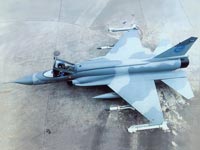Russia's Iconic MiG and Sukhoi Fighters Enter Competition with Chinese Clones
Chinese clones of Russian fighter jets have entered the world market, where they faced their original copies. The Chinese jets are three times less expensive than the Russian legendary MiG and Sukhoi fighter jets. Mikhail Pogosyan, the head of MiG and Sukhoi design bureaus, stated that he did not want to sign another large contract to deliver RD-93 engines, which China used for its FC-1 fighters, the clones of MiG-29.

Russian engineers are facing a tough choice: either to refuse from the contract worth $3.75 billion or lose African and Asian markets. China’s FC-1 does not have the advantage over Russia’s MiG-29 from the point of view of performance, but it is much cheaper: $10 million vs. $35 million. Beijing plans to sell not less than 1,200 copies of Su-27/30 and MiG-29 with a lethal discount for the Russian market.
Mikhial Pogosyan believes that the Chinese-made FC-1 has become direct competition for MiG-29. He has virtually blocked the signing of the contract to deliver 100 RD-93 jet engines to China. The official sent a letter to Russia’s defense export enterprise Rosoboronexport, in which he said that China’s FC-1 fighter was a competitor for MiG-29 on several markets overseas.
The engine delivery contract signed in 2005 is evaluated at $238 million. Russia also signed a framework agreement to deliver 500 engines. Beijing said that it would be ready to purchase up to 1000 engines in case Russian specialists enhance their performance. In this case the contract will total $3.75 billion. News agencies reported at the end of 2009 that the contract to deliver the next batch of 100 engines to China was to be signed by May 2010.
Russia Today: Made-in-China airplanes may undermine sales of Russian high quality jets
Deputy Director of Russia’s Rosoboronexport Alexander Mikheyev visited Egypt in April to discuss an opportunity to deliver 32 MiG-29 planes to the African nation. Egypt was in parallel talks with the makers of FC-1. Jane’s Defence Weekly wrote in March of this year that the government of Egypt started negotiations with Pakistan about the joint production of Chinese fighter jets. Egypt, the magazine wrote, was intended to purchase those jets for its Air Force. Russia gave its permission to re-export the RD-93 engines as parts of FC-1 to Egypt. The engine can also be shipped to Nigeria, Bangladesh, Saudi Arabia and Algeria.
China ’s FC-1 is a clone of the Russian MiG-29. In addition, China has launched the serial production of J-10 and J-11 jets, the rip-offs of Sukhoi 27 and 30.
Arms contracts with China have been the most profitable ones for the Russian defense industry. In 2003, China decided to make its own hardware, without Moscow’s participation.
China will soon be able to become a serious competitor to Russia in the field of state-of-the-art technologies. US intelligence said in May 2010 that China was developing a fifth-generation jet which could become a competitor to F-35, F-22 Raptor and Russia’s T-50. Pentagon officials said that the Chinese army would have state-of-the-art fighter jets during the upcoming eight years.
In June, it became known that Chinese engineers assembled the first prototype of the J-15 deck-based fourth-generation aircraft, a rip-off of Russia’s Su-33. Beijing attempted to purchase two Su-33 planes from Russia, but Moscow declined not to let the technology leak. The vessel for J-15 jets will also be built on the base of the Russian analogue – the Admiral Kuznetsov heavy cruiser. China received the technology for the production of the cruiser from Ukraine. In 1998 the former Soviet nation sold the Varyag aircraft carrier to Beijing for $20 million (Varyag and Admiral Kuznetsov are of the same series).
Novy Region
Subscribe to Pravda.Ru Telegram channel, Facebook, RSS!



